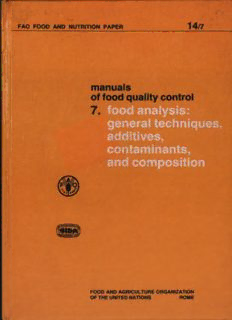
food quality control 7. food analysis: general techniques, additives, contaminants, and composition PDF
Preview food quality control 7. food analysis: general techniques, additives, contaminants, and composition
m- - : - 14/7 FAO FOOD AND NUTRITION PAPER manuals Of food quality control 7. food analysis: general techniques, additives, contaminants, and composition prepared by fao with the support of the swedish international development authority (sida) FOOD AND AGRICULTURE ORGANIZATION OF THE UNITED NATIONS Rome, 1986 The designations employed and the presentation of material in this publication do not imply the expression of any opinion whatsoever on the part of the Food and Agriculture Organization of the United Nations concerning the legal status of any country, territory, city or area or of its authorities, or concerning the delimitation of its frontiers or boundaries. M-87 ISBN 92-5-102399-9 All rights reserved. No part of this publication may be reproduced, stored in a retrieval system, or transmitted in any form or by any means, electronic, mechanical, photocopying or otherwise, without the prior permission of the copyright owner. Applications for such permission, with a statement of the purpose and extent of the reproduction, should be addressed to the Director, Publications Division, Food and Agriculture Organization of the United Nations, Via delle Terme di Caracalla, 00100 Rome, Italy. © FAO 1986 FOREWORD The control of food safety and quality Is an Integral part of national programmes for development. National food control systems are designed to protect the health and welfare of the consumer, to promote the development of trade in food and food products, and to protect the interests of the fair and honest food producer, processor or marketer against dishonest and unfair competition. Emphasis is placed on the prevention of chemical and biological hazards which result from contamination, adulteration or simple mishandling of foods. Also important are the maintenance of general food quality and the control of the use of food additives and food processing procedures. In order to establish a workable food control system, a national government must : 1. Enact food control legislation. 2. Promulgate regulations to enforce that legislation. 3. Create an agency to conduct the enforcement. 4. Establish food inspection and analysis staff within the agency or agencies concerned. 5. Provide physical facilities including a food control laboratory. To assist the national governments of developing countries in this process, FAO, with the support of the Swedish International Development Authority (SIDA) has published the series Manuals of Food Quality Control. These are incorporated as part of the FAO Food and Nutrition Paper Series No. 14, and include: No. 14/1 The Food Control Laboratory No. 14/2 Additives, Contaminants, and Techniques (out of print) No. 14/3 Commodities (out of print) No . 14/4 Microbiological Analysis No. 14/5 Food Inspection No. 14/6 Food for Export No. 14/7 Food Analysis: General Techniques, Additives, Contaminants, and Composition No. 14/8 Food Analysis: Quality, Adulteration, and Tests of Identity In addition, FAO, WHO and UNEP jointly have published many guidelines and other documents designed to further assist developing countries in forming adequate food control systems. These publications include: Methods of Sampling and Analysis of Contaminants in Food - A Report of the Second Joint FAO/WHO Expert Consultation, Rome - 1978 Guidelines for Establishing or Strengthening National Food Contamination Monitoring Programmes - FAO Food Control Series No. 5 - 1979 i i i • Guidelines for the Study of Dietary Intakes of Chemical Contaminants - WHO Offset Publication No. 87 - 1985 Guide to Codex Recommendations concerning Pesticide Residues, Part 2 - Maximum Limits for Pesticide Residues, Second Preliminary Issue - Rome - 1985 Recommended Practices for the Prevention of Mycotoxins in Food, Feed and their Products - FAO Food and Nutrition Paper No. 10, Rome - 1979 Food Standards, Codes of Practice and Methods of Analysis Recommended by the Codex Alimentarius Commission - Joint FAO/WHO Food Standards Programme (several titles) Food Additive Evaluations and Specifications of Purity and Identity - Reports and Monographs of the Joint FAO/WHO Expert Committee on Food Additives (several titles) The above publications, and others, are available to persons and organizations. FAO is also interested in receiving comments regarding this volume and suggestions for future improvement. Please send to: The Chief Food Quality and Standards Service Food Policy and Nutrition Division Food Agriculture Organization of the United Nations Via delle Terme di Caracalla 00100 Rome, Italy FAO wishes to acknowledge the generous support of the Swedish International Development Authority (SIDA), in the preparation of this volume, and the efforts of Mr. J. Weatherwax and Mr. P.G. Martin who were responsible for the preparation of the text. iv SPECIAL NOTE The methods and analytical procedures described in this Manual are designed to be carried out by properly trained personnel in a suitably equipped laboratory. In common with many laboratory procedures, the methods quoted frequently involve hazardous materials. For the correct and safe execution of these methods it is essential that laboratory personnel follow standard safety procedures for the handling of hazardous materials. While the greatest care has been exercised in the preparation of this information, FAO expressly disclaims any liability to users of these procedures for consequential damages of any kind arising out of or connected with their use. The methods are also not to be regarded as official because of their inclusion in this Manual. They are simply methods which have been found by experience to be usable in the average laboratory. v
Description: